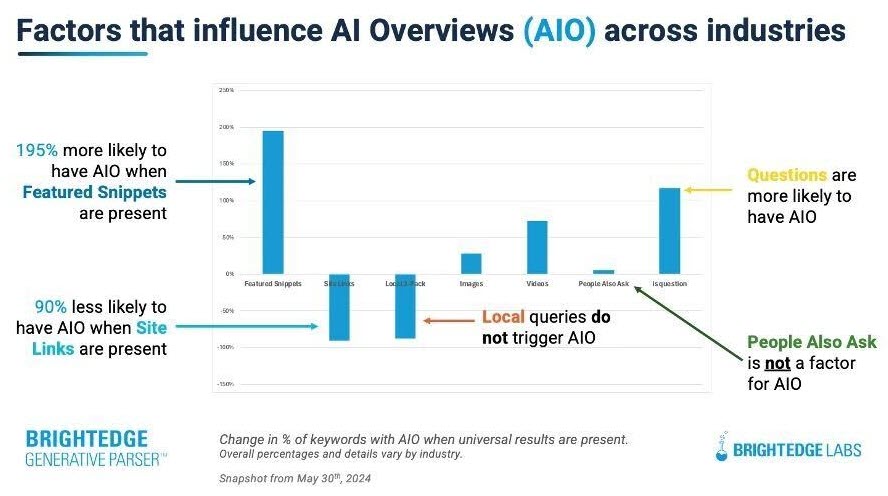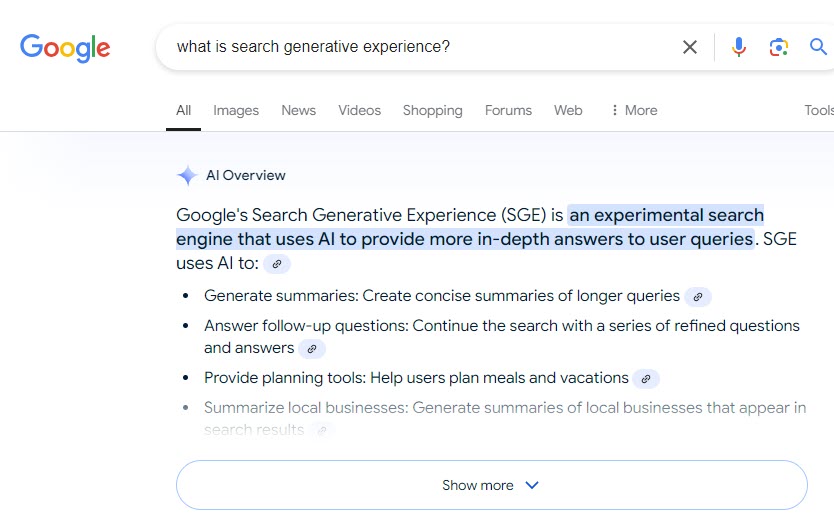Since the introduction of Google’s Search Generative Experience (SGE) in May 2023, the search landscape has evolved dramatically, especially for local SEO. Generative AI has changed how users interact with search results, altering click-through rates (CTR), engagement metrics, and overall website traffic. For local businesses and SEO professionals, these shifts pose new challenges and opportunities to rethink strategies and maximize visibility in an AI-powered environment.
Timeline of Google’s Generative AI Rollout
- May 2023: Google introduced SGE at its Google I/O event, providing users with access to AI-generated answers via Search Labs.
- August 2023: AI-driven search results began expanding across the U.S., reshaping how complex queries were handled.
- October 2024: SGE reached widespread use, leading to significant declines in organic traffic, increased zero-click searches, and more competitive SEO landscapes.
Also, there are factors that influence AI results across industries:

Key Impacts of Google’s Search Generative AI on Local SEO
1. Shift from Keyword-Centric to Context-Centric SEO
The launch of SGE marks a shift from traditional keyword optimization to a focus on contextual relevance. Google’s AI doesn’t rely solely on keyword matching but instead interprets the user’s intent, delivering context-rich results. This requires local SEO strategies to focus more on user intent, long-tail keywords, and the semantic meaning behind queries.
Actionable Tip: Local SEOs should prioritize creating comprehensive, contextually relevant content that aligns with specific user needs. Crafting content that naturally integrates long-tail, conversational keywords will be critical as Google’s AI continues to evolve in its understanding of natural language.
2. Decline in Click-Through Rates (CTR)
One of the most significant impacts of SGE is the decline in CTR. Since SGE provides detailed AI-generated summaries directly on the search results page, users are less likely to click through to individual websites. Studies have shown an 80% reduction in CTR for informational queries and a 30-60% drop in organic traffic.
This is especially true for top-of-funnel content, like listicles and educational posts. With users receiving much of the information they need in AI-generated snapshots, fewer visits are made to traditional web pages.
Actionable Tip: To combat this drop in CTR, local businesses need to focus on creating engaging, mid-funnel, and bottom-funnel content, such as transactional pages or content that encourages interaction through calls-to-action (CTAs). These types of content are less likely to be fully replaced by AI summaries.
3. Rise in Zero-Click Searches
The SGE contributes to the growing trend of zero-click searches, where users find their answers directly on the search results page without visiting any external website. This trend is expected to increase as SGE continues to refine its AI-generated responses.
This is particularly challenging for local businesses, as users may no longer need to click on listings in Google Business Profiles (GBP) for basic information like addresses, operating hours, or reviews. Instead, AI generates all of this directly in the search results.
Actionable Tip: Local SEOs should focus on optimizing their GBP listings to ensure the AI pulls accurate and comprehensive information. Encouraging customer reviews and keeping all business details up-to-date will ensure the AI-generated information is reliable and positive.
4. Increased Ranking Volatility
The rise of AI in search has led to increased ranking volatility. With SGE pushing traditional search results further down the page (sometimes by as much as 900 pixels), organic rankings have become less reliable. Ranking volatility makes it difficult for businesses to maintain stable organic visibility.
Actionable Tip: Regularly audit and update content to stay relevant. Focus on content that aligns with current user intent and consider adjusting your SEO strategy to emphasize high-quality content that resonates with both AI and human users. Maintaining an active content creation and updating schedule will help sustain relevance.
How Local SEOs Can Adapt to Google’s Generative AI
1. Focus on Content Quality and Relevance
The most significant takeaway for SEO professionals is the importance of producing high-quality, insightful content that addresses user needs in a meaningful way. Content must not only provide answers but also offer depth, value, and authority.
Actionable Tip: Build comprehensive content that covers local issues, frequently asked questions (FAQs), and other areas that align with user intent. This will improve the chances of being featured in SGE summaries, even if users don’t always click through.
2. Leverage Structured Data and Schema Markup
Implementing structured data (schema markup) can help Google better understand and display relevant business information in AI-generated summaries. For local SEO, this means ensuring that schema markup is applied to content like business addresses, phone numbers, services, and customer reviews.
Actionable Tip: Use tools like Google’s Structured Data Markup Helper to apply schema markup to your site. This will increase your chances of being pulled into AI-generated responses for local search queries.
3. Optimize for User Engagement Metrics
With AI prioritizing user experience, engagement metrics like bounce rate, dwell time, and interaction rates are becoming more important. SGE aims to improve the overall user experience by providing answers faster, which means your content should encourage longer stays and interactions.
Actionable Tip: Enhance your website with interactive elements such as videos, quizzes, or calculators to engage users. Improving site speed, ensuring mobile-friendliness, and creating visually appealing content will also boost engagement.
4. Monitor Paid Search Opportunities
As organic traffic declines, businesses should reconsider their paid search strategies. Ads positioned above AI-generated content are likely to see fluctuating CTRs, and cost-per-click (CPC) dynamics may shift as Google adjusts its SERP layout to accommodate AI-generated summaries.
Actionable Tip: Consider investing more in paid search (PPC) to maintain visibility. Work closely with your PPC team to optimize ad copy and placements, particularly in areas where organic traffic is declining.
Conclusion
Google’s Search Generative AI is reshaping the local SEO landscape in profound ways. While AI-generated results lead to reduced CTR and increased zero-click searches, businesses that adapt by focusing on content quality, context, and user engagement can still thrive. By embracing schema markup, improving engagement metrics, and refining paid strategies, local SEOs can continue to stay visible and competitive in this evolving search environment.







